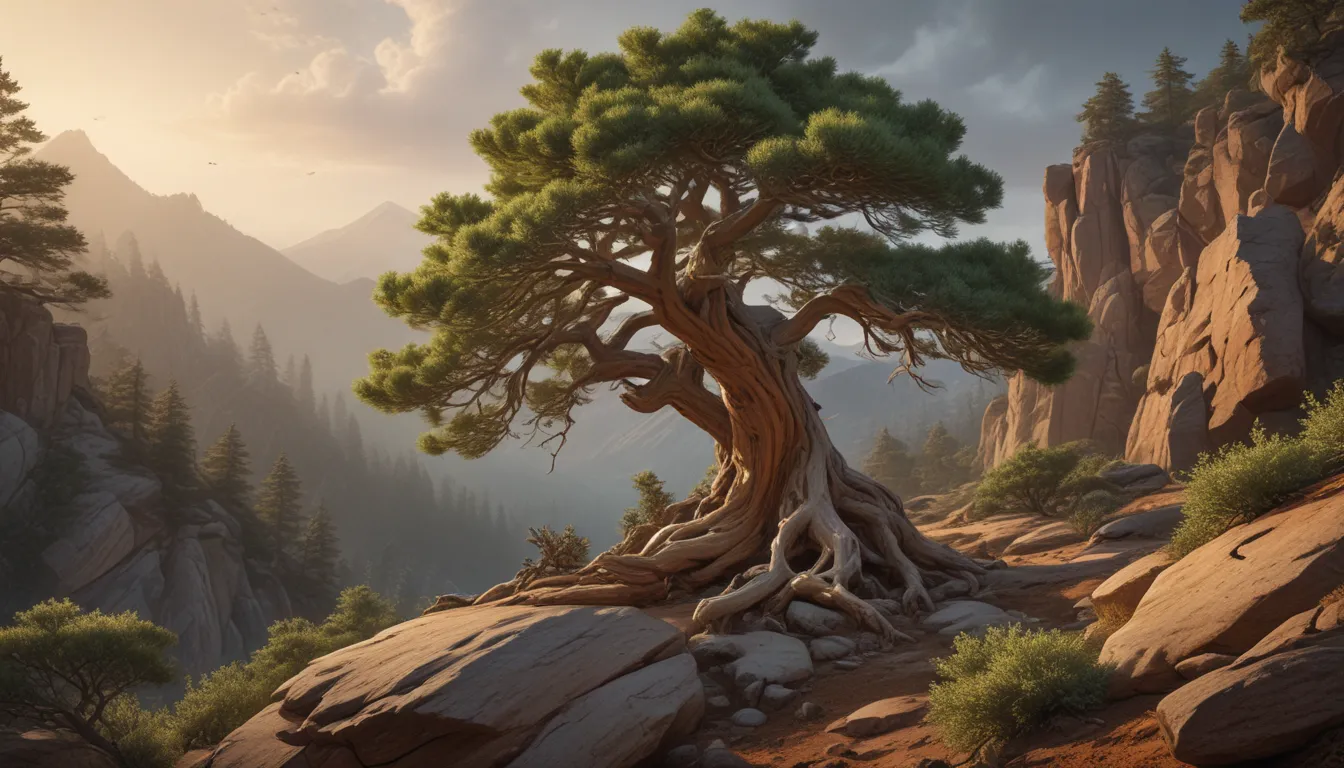The pictures we use in our articles might not show exactly what the words say. We choose these pictures to make you interested in reading more. The pictures work together with the words but don’t take their place. The words still tell you the important facts.
The Rocky Mountain juniper, scientifically known as Juniperus scopulorum, is a remarkable evergreen tree that thrives in the rugged terrain of the western United States. This resilient species, with its striking blue-green foliage and distinctive berry-like cones, plays a crucial role in the region's ecosystem and cultural heritage. Join us on an enlightening journey to discover 20 fascinating facts about this iconic plant, exploring its unique characteristics, ecological significance, and enduring legacy in the American West.
Unveiling the Essence of the Rocky Mountain Juniper
1. Resilient Longevity:
The Rocky Mountain juniper is a long-lived species, with some individuals exceeding ages of over 1,600 years. This remarkable longevity underscores the tree's resilience and adaptability in challenging environments, adding to its allure and appeal.
2. Aromatic Wood:
Highly valued for its durability, the tree's aromatic wood is often used in crafting furniture, fence posts, and decorative items. The distinct fragrance of the Rocky Mountain juniper wood enhances its desirability, making it a sought-after material for woodworking projects.
3. Vital Berries:
The tree produces small, bluish-purple berries that serve as a crucial food source for various bird species, including the cedar waxwing and the mountain bluebird. These berries play a vital role in the ecosystem, contributing to the tree's ecological significance and supporting wildlife populations.
4. Slow Growth Rate:
With an average growth rate of around 12 inches per year, the Rocky Mountain juniper is a slow-growing species. This deliberate pace of development contributes to the tree's dense and resilient wood, prized for its strength and endurance.
Embracing the Ecological Role of the Rocky Mountain Juniper
5. Environmental Adaptability:
Thriving in diverse habitats, from high-altitude mountain slopes to rocky canyons, the Rocky Mountain juniper showcases its adaptability to challenging environmental conditions. This versatility allows the tree to flourish in a wide range of landscapes, emphasizing its ecological resilience.
6. Habitat Enhancement:
A valuable species for wildlife habitat enhancement, the tree provides shelter and nesting sites for various bird species and small mammals. Its role in supporting wildlife populations highlights its ecological importance and contribution to biodiversity conservation efforts.
7. Resistance to Decay:
The tree's wood exhibits natural resistance to decay and insect damage, making it a preferred choice for outdoor construction and landscaping applications. This inherent durability and resilience make the Rocky Mountain juniper a favored material for outdoor projects.
8. Evergreen Beauty:
Maintaining its foliage throughout the year, the Rocky Mountain juniper offers consistent beauty and greenery in its surroundings. This year-round greenery enhances the visual appeal of landscapes, making it a desirable choice for ornamental and horticultural settings.
Exploring the Cultural Legacy of the Rocky Mountain Juniper
9. Native American Traditions:
With significant cultural and historical importance to Native American tribes, the tree's wood was utilized for crafting tools, ceremonial items, and shelter structures. The Rocky Mountain juniper holds deep cultural significance, symbolizing tradition and resourcefulness within indigenous communities.
10. Herbal Medicine:
The tree has a rich legacy in traditional herbal medicine, with various indigenous cultures utilizing its leaves and berries for their therapeutic properties. This medicinal significance reflects its cultural heritage and the enduring relationship between humans and the natural world.
11. Cultural Symbolism:
Enduring symbolism in art, literature, and folklore highlights the tree's timeless appeal and the inspiration it evokes in creative expressions. The Rocky Mountain juniper's presence in cultural narratives underscores its enduring significance and the depth of its impact on human creativity.
Honoring the Everlasting Beauty of the Rocky Mountain Juniper
12. Visual Appeal:
With distinctive blue-green foliage, the tree provides year-round visual interest and serves as a striking contrast in natural landscapes. Its unique coloration adds elegance to its surroundings, enhancing the aesthetic appeal of the areas it inhabits.
13. Silhouette Charm:
The tree's sturdy, gnarled trunk and twisting branches create visually captivating silhouettes, adding character to the rugged terrains it inhabits. The distinctive form and rugged appearance of the Rocky Mountain juniper make it a captivating presence in natural settings.
14. Shade and Shelter:
Providing valuable shade and shelter in the landscape, the tree creates microhabitats for a diverse array of flora and fauna. Its role in fostering microhabitats underscores its significance in supporting ecological diversity and ecosystem resilience.
15. Urban Adaptability:
With a compact size and adaptable growth habit, the Rocky Mountain juniper is suitable for urban and suburban environments. Its versatility in various settings highlights its potential for enhancing urban green spaces and community landscapes.
Embracing the Charm and Vitality of the Rocky Mountain Juniper
16. Low-Maintenance Beauty:
Requiring minimal care once established, the tree demonstrates high tolerance for drought and harsh growing conditions. Its low-maintenance characteristics make it an ideal choice for sustainable landscaping and conservation initiatives.
17. Dioecious Nature:
As a dioecious species with separate male and female trees, the Rocky Mountain juniper produces small, inconspicuous flowers that give rise to the characteristic blue berries. These reproductive characteristics contribute to its ecological role and genetic diversity within natural ecosystems.
18. Vital Contributions:
The tree's presence in the landscape contributes to the overall health and ecological balance of natural ecosystems, emphasizing its vital role in sustaining biodiversity. Its ecological contributions promote environmental resilience and preserve the integrity of natural habitats.
19. Enduring Legacy:
The Rocky Mountain juniper's enduring legacy, ecological significance, and cultural resonance make it a cherished emblem of the western North American landscape. Its timeless appeal and enduring beauty inspire admiration and reverence for generations to come.
20. Inspirational Enchantment:
With its enduring legacy and ecological significance, the Rocky Mountain juniper stands as a cherished emblem of the western North American landscape. Its resilience, beauty, and cultural resonance captivate enthusiasts and environmentalists, inspiring reverence for the remarkable plant life that surrounds us.
Conclusion
In conclusion, the Rocky Mountain Juniper is a captivating and resilient plant that holds great significance in various ecosystems. From its unique characteristics to its ecological contributions and cultural legacy, this iconic evergreen species continues to inspire admiration and reverence. By delving into the enchanting world of the Rocky Mountain Juniper and exploring its fascinating facts, individuals can deepen their connection to nature and gain a newfound appreciation for the wonders of the natural world.
FAQs
Ideal Growing Conditions:
- Rocky Mountain Junipers thrive in well-drained soil and prefer full sunlight for optimal growth.
- They are highly adaptable to various soil types and can withstand harsh weather conditions, making them suitable for diverse landscapes.
Pest and Disease Vulnerability:
- While generally resilient, Rocky Mountain Junipers can be vulnerable to spider mites and juniper blight.
- Regular monitoring and proper care can help prevent and manage these potential issues, ensuring the health and vitality of the plants.
Embrace the Wonder of Nature
Our dedication to delivering engaging and trustworthy content is at the core of our mission. Each fact shared about the Rocky Mountain Juniper is contributed by real users, ensuring a wealth of diverse insights and information. Trust in our commitment to quality and authenticity as you explore and learn about the wonders of nature with us.
Let the beauty and resilience of the Rocky Mountain Juniper inspire you to appreciate the magnificence of the natural world and the treasures it holds. Join us in celebrating the enduring legacy and ecological significance of this iconic tree, and embark on a journey of discovery and admiration for the wonders of the Western North American landscape.






